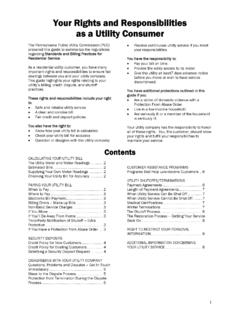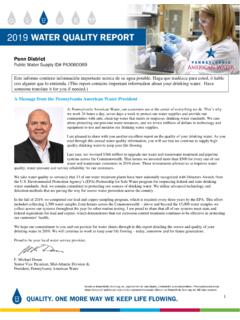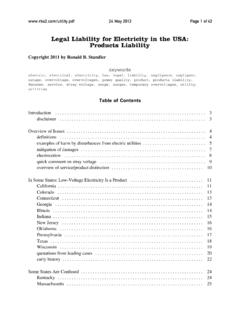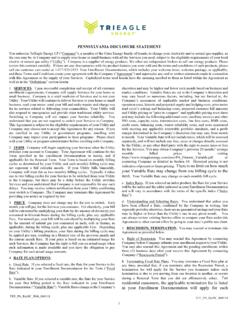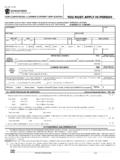Transcription of Whose Perspective? The Impact of the Utility Cost …
1 Template used with permission by IEPEC. Whose perspective ? The Impact of the Utility Cost Test Elizabeth Daykin, The Cadmus Group, Portland, Oregon Jessica Aiona, The Cadmus Group, Portland, Oregon Brian Hedman, Hedman Consulting, Portland, Oregon ABSTRACT As more states have adopted portfolio standards for energy efficiency, a majority have selected the Total Resource Cost Test (TRC) as the cost-effectiveness threshold utilities must meet. This trend, however, may be changing. In 2009, Utah altered course, and required all programs pass the Utility Cost Test (UCT), rather than the TRC.
2 Similarly, in 2008 Michigan passed Public Act 295, adopting the UCT as the cost-effectiveness screening test. Each test reflects a different perspective , and, depending on that perspective , desired outcomes can differ dramatically. This study examines: the theory behind each test perspective ; the rationale for adopting each test; and key outcomes, including achieved savings, overall cost-effectiveness, cost-per-kWh, and the diversity of program offerings. The paper also examines advantages lost when only one test is used in evaluating a program s worthiness, and a glimpse of energy-efficiency s future if more jurisdictions adopt the UCT over the TRC.
3 Overview The California Standard Practice Manual (California Manual) serves as the general standard of cost-effectiveness analysis in the United States (CPUC 2001), offering guidelines for measuring the cost-effectiveness of Utility -sponsored programs using the following five, defined tests: Total Resource Cost Test (TRC). Originally known as the All-Ratepayer Test, this test examines efficiency from the viewpoint of an entire service territory. This test compares the program benefits of avoided supply costs to costs for administering a program and the cost of upgrading equipment1.
4 When a program passes the TRC, this indicates total resource costs will drop, and the total cost of energy services for an average customer will fall. Ratepayer Impact Test (RIM). Originally known as the Non-Participant Test, RIM is also known as the no losers test. The RIM tests from the viewpoint of a Utility s customers as a whole, measuring distributional impacts of conservation programs. The test measures what happens to average price levels due to changes in Utility revenues and operating costs caused by a program.
5 A benefit/cost ratio less than indicates the program will influence prices upward for all customers. For a program passing the TRC but failing the RIM, average prices will increase, resulting in higher energy service costs for customers not participating in the program. Utility Cost Test (UCT). Also known as the Program Administrator Test (PACT), this test measures cost-effectiveness from the viewpoint of the sponsoring Utility or program administrator. If avoided supply costs exceed costs incurred by the program administrator, average costs decrease.
6 Participant Test (PCT). This test measures benefits and costs to customers participating in 1 Some states use a modified TRC which can include non-energy benefits or a lower discount rate more in line with the societal perspective ; however the California Manual strictly defines the TRC as including benefits only from avoided energy costs. Template used with permission by IEPEC. demand-side management (DSM) programs. The test compares bill savings against incremental costs of the efficient equipment.
7 It measures a program s economic attractiveness to customers, and can be used to set rebate levels and forecast participation. Societal Cost Test (SCT). A variation of the TRC, this test expands the point-of-view from the service territory to society s perspective . The TRC and the SCT differ in two important ways: 1) while the TRC uses an average cost of capital discount rate, the SCT uses a societal discount rate; and 2) the SCT also includes all quantifiable benefits attributable to a program, such as avoided pollutants, water savings, detergent savings, and other non-energy benefits.
8 A recent survey of cost-effectiveness requirements conducted by Cadmus indicates the TRC is the dominant cost-effectiveness test. Of 27 states reviewed for this study, 18 rely solely on the TRC or SCT. Three states review cost-effectiveness from multiple perspectives (including the UCT and TRC/SCT). Table 1 shows requirements by state. Jurisdictions clearly trend toward requiring the TRC when evaluating the economic worthiness of a measure, program, or portfolio of programs. Changes in multiple states confirm this trend: in Florida, which recently changed from using the RIM to the TRC; in New York, where the 2008 Energy Efficiency Portfolio Standards (EEPS) require all measures to pass the TRC (New York PSC 2008); and in Pennsylvania, where 2008 ACT 129 requires portfolios to pass the TRC (PA PUC 2009).
9 Table 1. Primary Cost-Effectiveness Test by State All tests TRC/SCT Primary Threshold UCT Primary Threshold IN, IA, NC CA2, CO, DE, FL, IL, ME, MA, MN, MO, NH, HJ, NM, NV, OH, OR3, PA, RI, VT, WA, WI CA, CT, MI, OR, TX, UT While the majority of jurisdictions use the TRC, a few notable exceptions point toward a newer trend of using the UCT. Utah relied on the TRC for a number of years, but replaced it with the UCT in 2009. Michigan, a state that adopted energy-efficiency standards in 2008 along with Pennsylvania and New York (TRC jurisdictions), prescribed the UCT as the cost-effectiveness threshold utilities must meet.
10 California has also shifted to a weighted TRC and UCT test, rather than the TRC alone (CPUC 2005). Before examining the rationale for selecting one test over the other, one must examine the differences between the two tests more closely. While similar, the UCT and the TRC differ significantly in calculating net benefits. The table below outlines costs and benefits associated with each test. Table 2. Benefits and Costs for TRC and UCT4 Total Resource Utility Benefits Utility avoided supply costs Tax credits Utility avoided supply costs Costs Program administrator costs Net participant costs Program administrator costs Incentives paid by sponsoring Utility 2 California uses a weighted UCT/TRC test.

